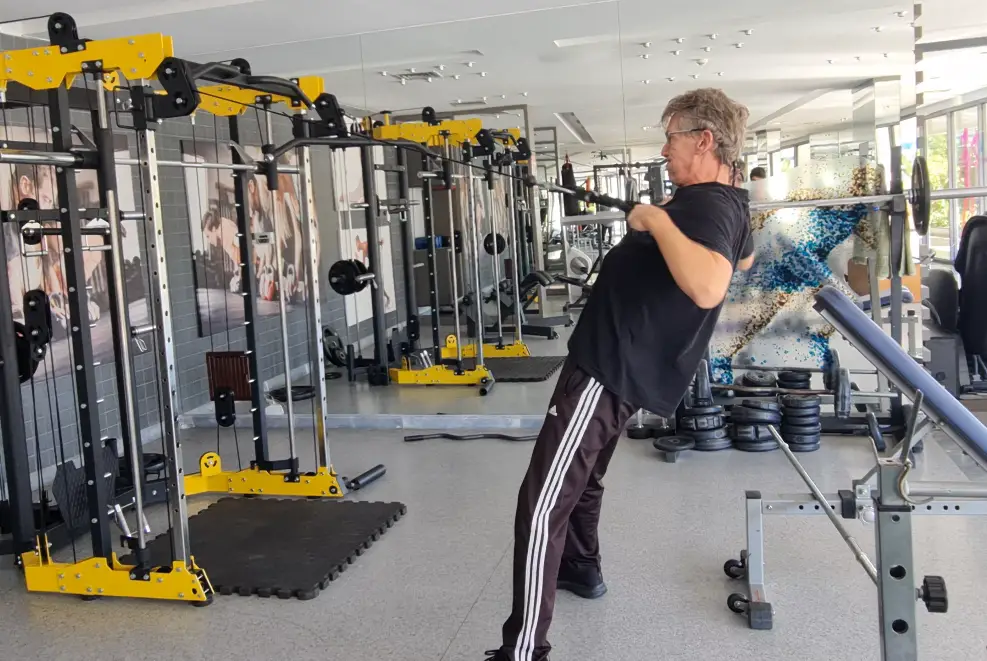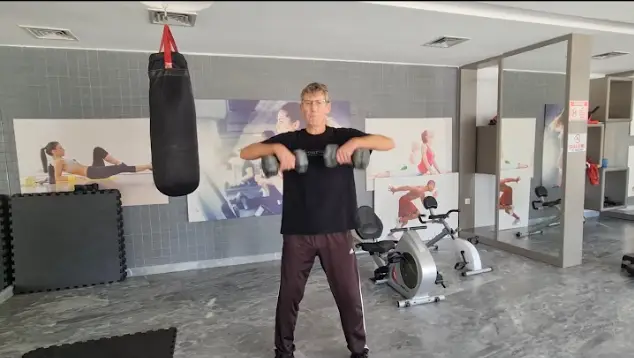All about the Upright Row
(Back & Shoulders)
BENEFITS & MUSCLES WORKED: Upper Back, Shoulders, Arms
Watch: my Upright Row video
START POSITION: Feet should be at least shoulder-width apart. Use a pronated grip (fingers over the top of the dumbbells). Stand upright and look straight ahead.
NOTES: Difficulty Rating: 42%
In terms of the difficulty/benefits ratio, the Dumbbell Upright Row is a great choice and fits in nicely somewhere at the end of a total Shoulder workout. Poor form will cause injury, so be careful. Common mistakes are lifting the dumbbells too high, using too much weight, and moving the lower back during the exercise.
The position of the Dumbbells at the top of the exercise is shown above. For total safety, do not exceed this limit. Note how the elbows are not higher than the top line of the Shoulders. However, some types of physique can safely go a little higher than this, such as those of gymnasts and other highly fit athletes.
The Dumbbell Upright Row is a good complementary exercise alongside the Dumbbell Shoulder Press, which should be done first, because the muscles used to press upwards are stronger. Remember, for any given grouping of exercises, always train the larger muscles first, followed by the smaller ones.
Breathe in as you lift, and out as you lower down again. Keep your legs and back rigid and avoid bending, rocking, twisting, or jerking.
Discover more about the simple but effective Upright Row exercise
(external link)
A few great exercises to do in the same session:



12 Top Tips for Dumbbell Upright Row – perfect form:
- Start with your feet shoulder-width apart, dumbbells in front of your thighs
- Keep your back straight and chest up
- Pull the dumbbells up towards your chin, keeping them close to your body
- Focus on leading with your elbows, not your hands
- Stop when your elbows are level with your shoulders
- Lower the dumbbells slowly
- Control the weight, don’t let it control you
- Breathe out as you lift, in as you lower
- Avoid shrugging your shoulders
- Keep your head in a neutral position, looking straight ahead. This helps maintain proper spinal alignment and reduces the risk of neck strain
- A slight bend in your knees can help with balance and stability during the upright row. It’s similar to the stance you’d use for a deadlift
- Don’t lock out your elbows at the bottom. Keep a slight bend in your elbows throughout the movement to protect the joint. Lower the dumbbells until
they’re back in front of your thighs, but maintain a soft bend
they’re back in front of your thighs, but maintain a soft bend
This exercise involves some fairly delicate muscles (upper back and shoulders), so most people should use light weights and high repetitions. This is a fabulous old-school exercise that offers enormous benefits, as long as the form is good and the weight is manageable.
This exercise is one I always recommend to people who come to me with shoulder problems/injuries. The exercise is excellent for stimulating blood flow to the shoulders and is suitable for doing high repetitions (with small dumbbells). It is also part of my primary shoulder sequence.

